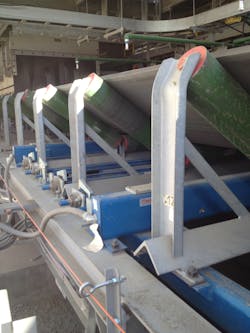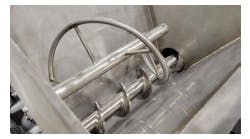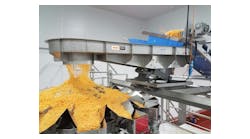Weighing up your options: Things to consider when choosing a conveyor belt scale
Conveyor belts are commonly used in many manufacturing industries to supply a continuous feed of raw materials for processing, and to transport the resulting product for further downstream operations. It is therefore crucial to be able to precisely measure and control this flow in order to maintain a robust operation and ensure high quality end products.
The most efficient way to determine the amount of material is, rather predictably, to weigh it, and a variety of integrated solutions have been developed to allow in-line weighing during high throughput operations. Modern conveyor belt scales are mostly electro-mechanical systems, and use speed and mass to determine both the instantaneous flow rate and the total conveyed weight.
Modern solutions
Most modern devices employ a scale carriage — a structure designed to transmit the gravitational force on the conveyer to a load sensor — to prevent measurement errors caused by lateral or torsional forces from off-center loading, belt movement and bearing friction.
Most carriages accomplish this by employing incredibly rigid designs, allowing them to resist deflection. A load cell detects the force transmitted by the scale carriage, and converts it to an electrical signal. Several load-sensing methods exist, but most modern solutions rely on a series of strain gauges or linear variable differential transformers. Belt travel distance must also be considered, and photo-optical segmented disks and electromagnetic pulse generators are ideal for generating the required electrical signals.
Finally, the running total of the conveyed material is calculated by a weight integrator, which cumulatively sums the load and belt travel. In addition to calculating the accumulated weight, most modern units also compute an instantaneous flow rate, providing real-time data for remote monitoring and control purposes.
Belt tension
State-of-the-art hardware alone does not automatically ensure reliable measurements, and there are many factors that can affect scale accuracy and repeatability. For example, if the tension of the conveyor is too high, it can lead to bridging — the scale failing to register the entire weight of the belt and material — resulting in an under estimation of tonnage. Conversely, if the tension is too low, then the sagging of the belt may cause the material to shift as it travels over the protruding idlers. This can cause repeatability errors and material spillage, and can also lead to premature conveyor wear.
Even if the belt is perfectly tensioned during the commissioning of the scale, ongoing operation can lead to gradual tightening or loosening from influences such as temperature fluctuations, ineffective gravity tensioners, changes of feed material, varying inclines and erratic belt tracking. In reality, there is an ideal amount of belt sag to aim for — usually around two percent — and drifts of just one percent from the optimal tension can affect scale accuracy and repeatability by as much as 10 percent.
Scale location
In addition to the belt tension, accurate measurements are highly dependent on the location of the scale. Many load cells are highly sensitive to vibration, moisture and changes in temperature, and can benefit from installation in a sheltered location.
Additionally, although modern scale carriages are designed to only transmit vertical loads, they are not infallible. Consequently, it is advisable to avoid installing scales on steep inclines, curved sections or areas prone to off-center belt loading to decrease the chance of erroneous lateral and torsional forces skewing the results.
Continued maintenance and calibration
Even with a scale installed in the ideal location — complete with optimal belt tension — things can still change over time, and even relatively small non-linearities from worn-out bearings, misaligned idlers and the drift of electronic components can add up to expensive compounding errors.
For example, if a scale registering a two percent error is responsible for the annual billing of a million tons of material — valued at $100 per ton — then the annual cost of the discrepancy would be a staggering $2 million. However, careful tweaking of the system to reduce this error to 0.25 percent would bring down the associated cost to just $0.25 million. This highlights the importance of maintaining a regular preventative maintenance program, ensuring that the entire system — not just the scale — is in top working order.
Of course, an important part of any equipment maintenance is regular calibration. The calibration process for a belt scale, however, is inherently more complex than that of a differential weighing system, since the subject in question is in motion. Nevertheless, there are a variety of different techniques available to ensure satisfactory calibration, with the most suitable method dependent on the application and the regulatory body — if any — with process oversight. For highly regulated applications, the calibration must be performed by an authorized agent of the approving agency.
Choose wisely
Even regular calibration cannot make up for the inaccuracies of an unsuitable scale, and careful consideration of system specifications is crucial to ensure a good match with the desired application.
Different processes often require varying levels of accuracy to maintain a particular operating range. For example, custody transfer of agricultural grain in the U.S. is a highly regulated affair, and can often require measurements to be within ±0.125 percent to secure National Type Evaluation Program certification.
Conversely, other processes may be less stringent and only require alarms to be raised in potentially harmful or costly situations, such as too much rock being fed into a quarry crusher. In such cases, a ±2 percent error or even higher may be perfectly satisfactory.
Consideration of operating range is equally important, as installing a scale designed to process tons of material per minute will prove inaccurate and needlessly expensive if the operation in question only uses 10 percent of its range. The electronic controller systems used with scales also differ wildly in specification, offering various levels of data-handling, control architecture and communication outputs to satisfy a wide range of needs.
Conclusion
Belt scales have been through several design iterations over the years before settling on the current electro-mechanical industry standard. They have proven themselves to be important process manufacturing tools across a wide range of industrial operations, providing a layer of quality control assurance which would not otherwise be possible.
However, it is important to remember that a scale will only perform as well as the surrounding environment allows, and worn components, inadequate belt tensioning and poor choice of scale location can lead to misleading results. Furthermore, belt scales are not one-size-fits-all solutions, and it is crucial to ensure that the scale specifications are a good match for the application.
Simply put, when in the market for a conveyor belt scale to enhance your manufacturing process, it pays to weigh up your options.
Andrew Clarke is product manager – bulk material handling at Thermo Fisher Scientific.




